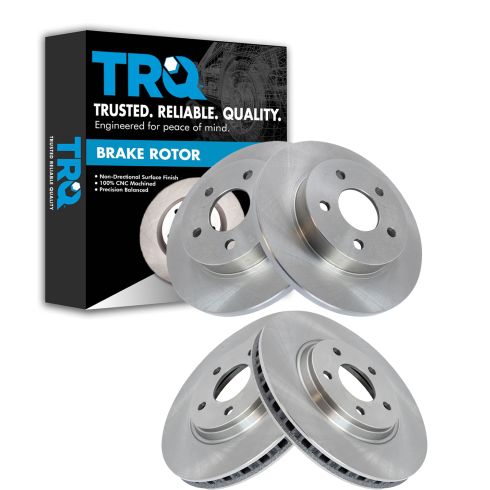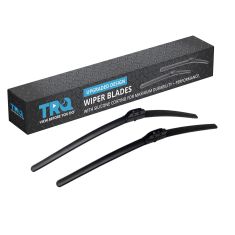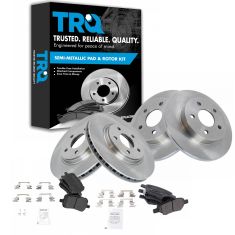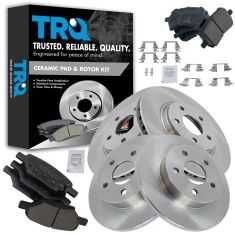Replaces
2009 Pontiac G6 Front & Rear 4 Piece Brake Rotor Set TRQ BRA13735






BRA13735
This part doesn’t fit a . Select from parts that fit.
Specify your vehicle's year, make and model to guarantee fit.
This part doesn't fit a . Select from parts that fit.
Buy in the next and
Orders must be placed by 2pm ET
Recommended for your 2009 Pontiac G6
Part Details
- (2) Front Brake Rotors
- (2) Rear Brake Rotors
- 5 Lug
- Solid
- No
- 4 Piece
- 11.65 in. (296mm)
- Vented
- 10.63 in. (270mm)
- Standard Replacement
Specifications
- Front & Rear
About TRQ:
TRQ is a trusted brand dedicated to making every repair a success story by combining premium parts with easy installation. Each TRQ part is engineered by a team of automotive experts to meet or exceed OEM standards, delivering enhanced performance and maximum longevity. With rigorous in-house testing, the brand ensures superior fit and function across every product line. TRQ also provides customers with best-in-class, step-by-step installation videos—so you can complete repairs with confidence, whether you're a first-time DIYer or an industry professional.
Product Features
TRQ brake rotors are manufactured using premium G3000 casting alloy to reduce noise while braking and enhance service life. TRQ rotors have a non-directional finish to minimize the break-in period for new rotors and reduce vibrations throughout the rotor’s lifecycle. TRQ recommends replacing brake pads when you replace rotors to ensure even wear and improved component performance. All products are fit and road-tested in our Massachusetts R&D facility to ensure we deliver on our promise of Trusted Reliable Quality.
Attention California Customers:
![]() WARNING: This product can expose you to chemicals including Lead and Lead Compounds, which are known to the State of California to cause cancer, and birth defects or other reproductive harm. For more information, go to www.P65Warnings.ca.gov.
WARNING: This product can expose you to chemicals including Lead and Lead Compounds, which are known to the State of California to cause cancer, and birth defects or other reproductive harm. For more information, go to www.P65Warnings.ca.gov.
Lifetime Warranty
This item is backed by our limited lifetime warranty. In the event that this item should fail due to manufacturing defects during intended use, we will replace the part free of charge. This warranty covers the cost of the part only.
FREE Shipping is standard on orders shipped to the lower 48 States (Contiguous United States). Standard shipping charges apply to Hawaii and Alaska.
Shipping is not available to a P.O. Box, APO/FPO/DPO addresses, US Territories, or Canada for this item.
Expedited is available on checkout to the United States, excluding Alaska, Hawaii.
Final shipping costs are available at checkout.



Created on:
Tools used
- Loosen the lug nut covers with a 19mm socket Remove the center cap Loosen the lug nuts with the vehicle on the ground Raise the vehicle with a floor jack Secure the vehicle on jack stands Remove the lug nuts Pull off the wheel
- Turn the rotor by hand or turn the steering wheel to turn the rotor Check the thickness of the brake pads Check the brake pad wear indicator Check for gouges on both sides of the rotor
- Remove bolts from the brake caliper with a 14mm wrench, holding the slide with a 19mm wrench Pry the brake pads into the caliper with a flat blade screwdriver to push in the pistons Pull the caliper aside Pry the brake pads off with a flat blade screwdriver
- Remove the 13mm bolts from the brake caliper bracket Pull off the brake caliper bracket Pull the rotor off
- Spin and reset the pistons with a caliper piston reset tool Clean the brake pad slides with a wire brush Apply grease to the caliper slides
- Slide the rotor on Put the bracket back into place Start the bolts by hand Tighten the bolts between 25 and 35 foot-pounds of torque
- Apply grease to the brake pad tabs Install the new brake pads into the bracket Turn the piston to fit the brake pad Put the caliper on Thread bolts with a 14mm and 19mm wrench Tighten bolts between 18 and 19 foot-pounds
- Slide the wheel into place Start the lug nuts by hand Tighten the lug nuts preliminarily Lower the vehicle to the ground Tighten the lug nuts to 100 foot-pounds in a crossing or star pattern Reattach the center cap Tighten the lug nut covers with a 19mm socket
- Pump your brakes repeatedly until they feel firm Test your brakes at 5 miles per hour and then 10 miles per hour Road test the vehicle
Brought to you by 1AAuto.com, your source for quality replacement parts and the best service on the Internet.
Hi, I'm Don from 1A Auto. I hope this how-to video helps you out, and the next time you need a part for your vehicle, think of 1AAuto.com. Thanks.
In this video, we're going to show you how to replace or do a rear brake job on this 2007 Pontiac G6. It's the same as any 2005 to 2010 G6, as well as the Saturn Aura. We show you the right hand side, which is the same as the left hand side. You'll need new brakes from 1AAuto.com, jack and jack stands, 13mm, 14mm, and 19mm wrenches as well as sockets, a ratchet, large screwdriver, wire brush, a caliper piston reset tool, and brake or white grease. Our car has good brakes on it so we just take them apart and put them back together to show you.
Start by using a 19mm socket, and depending on what wheels you have, this has wheel covers, so unscrew the caps and then the wheel cover comes off. If you don't have the benefit of air tools, you'll want to loosen the lug nuts with the vehicle on the ground. Then raise and secure the vehicle, and then remove the lug nuts, wheel, and tire.
With the wheel off, you can see our pads have good life. Run the back of your fingernail on the disc. There's no groove. These brakes are actually in pretty good shape. We'll take them apart and put them back together to show you. Holding the caliper is two 14mm bolts. We'll speed up here. We use a 14mm wrench on the bolt. Then we actually have to hold the slides with either a 19mm or a 13/16 wrench. Now use a large screwdriver or small pry bar and just pry between the caliper and the disc. That will help loosen the caliper up a little bit. Now you can lift the caliper off.
Now the pads will pull out. For the inside pad, or maybe even the outside pad, you might want to use a screwdriver for a little extra leverage. Put it in between the pad and the rotor, and just pry it right out. Two 13mm bolt holds the bracket. We'll speed up here as we use a 13mm socket with a ratchet to remove those two bolts and remove that caliper bracket. Then we can remove the disc as well.
In order to put the brakes back together we'll need to reset the piston in the caliper. You need a special tool that actually spins the piston. You can see it there. It's available at most of our auto parts stores. Put that in with an extension. Hook your ratchet up to it, and then hold your caliper steady while you spin the piston back in. You're both turning the piston and pushing it back into the caliper.
Now make sure the slides in your caliper bracket are free. If they're not, if they're gummed up at all, pull them out like that, clean it up, re-grease them. Make sure they're nice and free. Then you'll want to wire brush the stainless steel slides where the brake pads sit.
Reinstall the rotor. Now reinstall the bracket and start the bolts in. Then we'll tighten up the bolts, and you'll want to torque them between 25 and 35 foot-pounds. Now apply a little bit of brake or white grease into the slides where you're going to install the brake pads into. The pads have a little notch in them, so you want to make sure you position the piston at the correct clock position so it'll slide down over the pads. We'll just turn the piston a little bit.
Now we're going to take our pads and put them into the slides. Make sure they go in correctly. They should be nice and free and moveable. Make sure, also, again, that you have the piston lined up so that it will go right down onto the pad. We put the pads in place. I will speed up here as we put the caliper back on. If you have any issue at all with that caliper going down at all onto the bracket, just check your caliper piston. Make sure it's lined up correctly. We'll put those bolts back on with our 14mm as well as our 19mm wrench. You want to just tighten these up nice and snug. They should be about between 18 and 19 foot-pounds.
Speed up here as we put our wheel and tire back on. Just start the lug nuts on there by hand first, and then tighten them preliminarily. With the car back down on the ground, we'll tighten the lug nuts to 100 foot-pounds using a star pattern. Last, but not least, put our wheel cover on there. Put the caps on carefully only using hand power to tighten those caps up. Last, but certainly not least, make sure you pump up the brakes. Get a nice firm pedal before road testing the vehicle.
We hope this video helps you out. Brought to you by www.1AAuto.com, your source for quality replacement parts and the best service on the Internet. Please feel free to call us toll-free, 888-844-3393. We're the company that's here for you on the Internet and in person.
Tools used
- Loosen the lug nut covers with a 19mm socket Pry off the center cap with a flat blade screwdriver Loosen the lug nuts with the vehicle on the ground Raise the vehicle with a floor jack Secure the vehicle on jack stands Remove the lug nuts Pull off the wheel
- Turn the rotor by hand or turn the steering wheel to turn the rotor Check the thickness of the brake pads Check the brake pad wear indicator Check for gouges on both sides of the rotor
- Remove 14mm bolts from the brake caliper Pull the caliper aside Pry the brake pads off with a flat blade screwdriver Remove the brake pad brackets If only changing the pads, continue to Step 6 and install the new pads
- Remove the 15mm bolts from the brake caliper bracket Pull off the brake caliper bracket Pull the rotor off
- Slide the rotor on Thread on one lug nut to hold the rotor in place Use a large C-clamp and the old pad to push the pistons back Apply anti-seize fluid or white grease to the slides Push the slides on Remove the brake pad slides Put the bracket back into place Start the 15mm bolts by hand Tighten the bolts to 65 foot-pounds of torque
- Clean the brake pad brackets with a wire brush Push the brackets onto the caliper bracket Apply grease to the brake pad tabs Install the new brake pads into the bracket Put the caliper on Thread bolts the 14mm by hand Tighten bolts to 35 foot-pounds
- Slide the wheel into place Start the lug nuts by hand Tighten the lug nuts preliminarily Lower the vehicle to the ground Tighten the lug nuts to 100 foot-pounds in a crossing or star pattern Reattach the center cap Tighten the lug nut covers with a 19mm socket
- Pump your brakes repeatedly until they feel firm Test your brakes at 5 miles per hour and then 10 miles per hour Road test the vehicle
Brought to you by 1AAuto.com, your source for quality replacement parts and the best service on the Internet.
Hi, I'm Don from 1A Auto. I hope this how-to video helps you out, and the next time you need a part for your vehicle, think of 1AAuto.com. Thanks.
In this video, we're going to show you how to remove, inspect, and replace front brake pads and rotors on a 2007 Pontiac G6. It's fundamentally the same from 2005 to 2010, and from the left side to the right side. The items that you are going to need are jack and jack stands, 19mm, 15mm, and 14mm socket and ratchet, flat blade screwdriver, C-clamp, and some brake grease.
Remove the plastic caps on the lug nuts with a 19mm socket. I'll fast-forward as I take those all off. Use a 19mm socket and socket wrench. If you have an air tool, go ahead and use that. You're going to remove the five lug nuts, and I'll fast-forward through that.
By hand, turn the hub assembly so that you can gain better access behind it. Doing a general front brake inspection, look through the window to see how much thickness is on the inside pad. Check your rotor. Run your finger along and check for any deep grooves or gouges. Then, check the outer pad thickness from where I'm pointing.
Use a 14mm socket and socket wrench, and remove the two bolts that hold the caliper to the caliper bracket. I'll fast-forward through removing those two 14mm bolts. Pull the caliper up and off of the caliper bracket and put it up and to the side.
Take a screwdriver and pry the pad away from the rotor. Do that for both the inner and outer pad. Remove the upper and lower metal brake pad guides. Using a 15mm socket and socket wrench, remove the two bolts that hold the caliper guide to the spindle assembly. I'm going to fast-forward as I take out those two 15mm bolts. Pull the caliper bracket up and out. Remove the brake rotor.
Our brakes were fine, so we're going to reinstall them. Go ahead and put your new rotor on. Then you can use a lug nut to keep it pressed against the hub while you finish up the brake work. I'm positioning the caliper so that I can use a C-clamp to push the piston back into the caliper. You can do this with a C-clamp, or you can do it with a pair of large water pump channel lock style pliers. What you're going to want to do is put the screw clamp onto the piston, tighten it, which forces the piston back into place.
I'm going to reposition the wheel so that I can get that access to the back of it. Before I go ahead and put that caliper bracket back on, I want to make sure that the slides are well greased. I'll pull them out with the boot, and check to make sure that there's grease on them. If there isn't, I will do that, and go ahead and push that boot back onto the caliper bracket. I'm going to do that for both of those just to make sure everything is good. Then, I'm going to go ahead and put that caliper bracket back on with the 15mm bolts. I'm going to fast-forward as I reinstall those two 15mm bolts. I'm going to torque the two 15mm bolts to approximately 65 foot-pounds.
Clean up the metal slides that you took off the caliper bracket with a wire brush. Then reinstall them to both the top and bottom. Take your pads and lube up with a little brake grease the ends that will get in contact with those caliper slide brackets, and then, go ahead and slide them into place. Go ahead and take your caliper and slide it over the brake pads and onto the caliper bracket, lining it up with the two slides, top and bottom.
Reinstall the bolts that hold the caliper to the caliper bracket. I'm going to go ahead and fast-forward through that. Torque the two caliper bolts to roughly 35 foot-pounds.
Reinstall the wheel and tighten up the lug nuts. I'm going to use an air gun, so I will fast-forward through this. I'm going to torque the five lug nuts to roughly 100 foot-pounds, and I'm going to do it in a star pattern. Now, reinstall your hub cap, and I'm going to do that with that 19mm socket, and I'm just going to screw them in by hand.
Also, we want to make sure that you line up the valve stem with the notch in the hub cap for the valve stem. I'm going to fast forward through tightening that up.
We hope this video helps you out. Brought to you by www.1AAuto.com, your source for quality replacement parts and the best service on the Internet. Please feel free to call us toll-free, 888-844-3393. We're the company that's here for you on the Internet and in person.

BRA13735
877-844-3393
Monday - Friday 8:00am - 9:30pm ET
Saturday - Sunday 8:00am - 4:30pm ET
Specify your vehicle's year, make and model to guarantee fit.
This part doesn't fit a . Select from parts that fit.







